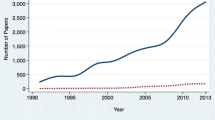Abstract
The time has come for urban social indicator research to converge with the basic substantive efforts of urban researchers. Such a convergence may propel both basic and applied researchers toward more fruitful outcomes. This paper argues that the traditional model of urbanism provides the medium for the convergence. When urbanism is conceptualized to be multidimensional, seemingly discreet indicators of demographic, economic, social, and environmental conditions in cities may be incorporated into a more general model of urban structure and change. Specifically, using social indicators for 195 cities from ZPG's Children's Stress Index and the 1990 U.S. Census, we show empirically: (1) Urbanism is a complex factor with four distinct dimensions: demographic scale, economic stress, social stress, and environmental stress. (2) These four dimensions of urbanism may be reliably measured with standard composite variables used in today's social indicator research. (3) Within the Urbanism factor there are causal connections among the separate dimensions, the most basic of which is that asserted by arguments from the traditional theory of urbanism; specifically, that population size, density, and social heterogeneity are causally linked to stress in economic, social, and environmental systems of the city.
Similar content being viewed by others
References
Angell, R. C.: 1951, The Moral Integration of American Cities (University of Chicago Press, Chicago, IL).
Baron, L.: 1993, ‘The heirs of our ways’, The ZPG Reporter 25(2/3), 1–4.
Bentler, P. M.: 1985, Theory and Implementation of EQS: A Structural Equations Program (BMDP Statistical Software, Los Angeles, CA).
Berry, B. J.: 1972, (ed.) City Classification Handbook: Methods and Applications (Wiley-Interscience, New York, NY).
Blalock, H. M. Jr.: 1969, Theory Construction (Prentice-Hall, Englewood Cliffs, NJ).
Bollen, K. A.: 1989, Structural Equations with Latent Variables (John Wiley & Sons, New York, NY).
Boyer, R. and D. Savageau: 1989, Places Rated Almanac (Prentice Hall, New York, NY).
Burgess, E. W.: 1925, ‘The growth of the city: An introduction to a research project’, in R. E. Park, E. W. Burgess, and R. D. McKenzie (eds.), The City (University of Chicago Press, Chicago, IL), pp. 47–62.
Carter, H.: 1981, The Study of Urban Geography (Edward Arnold, London).
Clark, T.: 1972, ‘Urban typologies and political outputs’, in B. J. Berry (ed.), City Classification Handbook: Methods and Applications (Wiley Interscience, New York, NY), pp. 152–178.
Fischer, C.: 1973a, ‘On urban alienation and anomie’, American Sociological Review 38, 311–326.
Fischer, C.: 1973b, ‘Urban malaise’, Social Forces 52, 221–235.
Fischer, C.: 1975, ‘Toward a subcultural theory of urbanism’. American Journal of Sociology 80, 1319–1351.
Fischer, C.: 1984, The Urban Experience (Harcourt Brace Jovanovich, New York, NY).
Kasarda, J. D. and M. Janowitz: 1974, ‘Community attachment in mass society’, American Sociological Review 39, 328–339.
Marlin, J. T.: 1992, The Livable Cities Almanac (Harper Collins, New York, NY).
Marvick, E. W. and A. J. Reiss, Jr.: 1956, Community Life and Social Policy (University of Chicago Press, Chicago).
Milgram, S.: 1970, ‘The experience of living in cities’, Science 167, 1461–1468.
Reckless, W.: 1933, Vice in Chicago (University of Chicago Press, Chicago, IL.).
Schneider, K. R.: 1979, On the Nature of Cities (Jossey-Bass, San Francisco: CA).
Schwab, W. A.: 1992, The Sociology of Cities (Prentice-Hall, Englewood Cliffs, NJ).
Sharma, R.: 1993, ‘Redirecting foreign aid’, The ZPG Reporter 25(2/3), 2.
Shaw, C., H. D. McKay, L. Cottrell, F. Thrasher and H. M. Zorbaugh: 1925, Delinquency Areas (University of Chicago Press, Chicago, IL.).
Shaw, C. and H. D. McKay: 1942, Juvenile Delinquency and Urban Areas, (University of Chicago Press, Chicago, IL.).
Simmel, G.: 1950, ‘The metropolis and mental life’, in K. H. Wolff (ed.), The Sociology of George Simmel, (The Free Press, New York, NY), pp. 409–424.
The ZPG Reporter: 1993, ‘Children's stress index’ 25, unnumbered insert.
Tonnies, F.: 1887/1957. Community and Society (Trans. and ed. by C. P. Loomis, Harper Torchbook, New York).
Weiss, M. J.: 1988, The Clustering of America (Harper & Row, New York, NY).
Wirth, L: 1938, ‘Urbanism as a way of life’, American Journal of Sociology 44, 3–24.
Wish, N.: 1986, ‘Are we really measuring the quality of life? Well-being has subjective dimensions, as well as objective ones’, American Journal of Economics and Sociology 45, 93–99.
Zorbaugh, H.: 1929, The Gold Coast and the Slum (University of Chicago Press, Chicago, IL.).
Author information
Authors and Affiliations
Rights and permissions
About this article
Cite this article
Schwirian, K.P., Nelson, A.L. & Schwirian, P.M. Modeling urbanism: Economic, social and environmental stress in cities. Soc Indic Res 35, 201–223 (1995). https://doi.org/10.1007/BF01079027
Accepted:
Issue Date:
DOI: https://doi.org/10.1007/BF01079027




